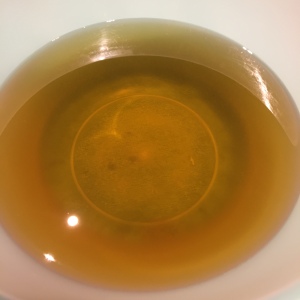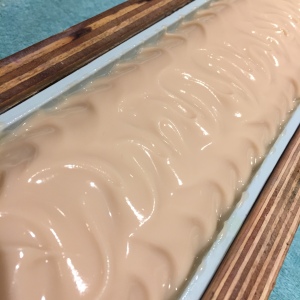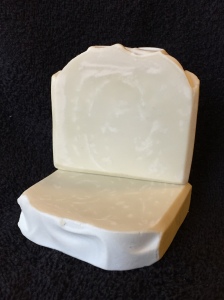Traditional castile soap is made of nothing more than olive oils and a sodium hydroxide solution, and its origins lie in the soap that has been made for many centuries in Aleppo (Syria), from local olive & laurel berry oils. When the recipe was brought to Europe (specifically the Castile area of Spain, with its abundance of olive trees) it would appear that laurel berry oil was hard to come by, leading to it being dropped completely, becoming the 100% olive oil soap that we know today. It’s considered to be the gentlest of soaps – kind to sensitive skin often used as a baby soap (though personally I don’t think very small babies need any soap at all!)
At the beginning of the year I decided to make it one of my goals for January, and hey presto, last week I made my first ever batch of castile. I don’t always bother with test batches, and I didn’t think an awful lot could go wrong with this one, so dove right in with a full sized batch. The recipe was simply:
- 1500g Olive Oil
- 570g Water
- 193g Sodium Hydroxide (NaOH)
I used my usual method – made up the lye solution and left it to cool down to room temperature. For my regular bars I melt together the hard oils/butters, then add the liquid oils and let it cool down to room temperature, but there was none of that faffing about with this one – I just measured my olive oil out of the bottle and into my mixing bowl.

Olive Oil
Then added the NaOH and whisked until it was emulsified:

Oil / NaOH Emulsified
Gave it a bit of a mix with the handblender until it traced:

Soap Batter at Trace
And poured it into the mould:

Castile in the mould
I knew from my reading that I probably wouldn’t be able to unmould / cut after my usual 48 day wait, so I left it a little longer, then kind of forgot about it for a couple of days (oops) and eventually unmoulded it 8 days after it was poured. I was happy to note that it was a lot whiter than it originally appeared to be:

Castile 8 days later
Perhaps I’ll only leave it three or four days next time as it was the hardest batch I’ve ever cut, and I feared for the wire on my poor Bud soap cutter. I took it slowly, and the end result was this:

Castile freshly cut
The usual recommendation is to allow castile soap to cure for a good six months, if not more, as it’s notoriously slow to harden. I’m not convinced though, and will be testing it often in the next few months to see how it’s developing.
By the way, I’ve never actually used castile soap myself. The things I’ve heard haven’t always been particularly positive – the lather has even been described as ‘slimy’, so I’m going to (try to) put the opinions of others out of my head and be as objective as possible. Stay tuned and I’ll keep you updated 🙂

Nice work Vicki, do you pH test? I wonder how the castille would go with HP…
Maybe your olive oil was fairly high in saturated fats (the content in olive oil can vary) and that made it harder?
You might be right…no real way of knowing I guess 🙂 I was pretty surprised – came very close to leaving it too late to cut – yikes! I don’t pH test – I tried the strips a couple of times but didn’t find them particularly accurate or helpful.
If you put the olive oil in the fridge and it gets a layer of solid fat on top – that’s the saturated fat. Some olive oils just end up with a few solid white dots floating through and some will get an actual layer…
I use the pH strips just to satisfy myself that the soap is ready to use (used them a lot when first doing HP, but less now).
Well done on your goals!! Clearly my blogtober effort used up all my blog power for a few months 😂 Will get there again soon 😊
I’ll look forward to you posting again 😊 Thanks for the info.
Pingback: The Week in Soap: 22nd Jan ’17 | The Soap Mine
Oh I do love the look of this, although I love your colourful swirly soaps too! The recipe sounds so simple! #DreamandSparkle
Very simple indeed! Can’t wait to start using it 😊
I have never heard of Castile soap so will be interested to hear your thoughts on it! #DreamandSparkle
Can’t wait to try it myself, but I need to be patient 😊
Pingback: The Week in Soap: 19th March ’17 | The Soap Mine
Pingback: Castile, a quick update | The Soap Mine